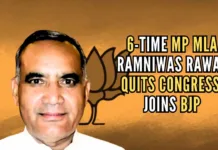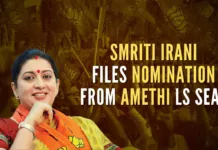
BJP emerged as the single largest party in the UT of J&K
It’s true that the Bharatiya Janata Party (BJP) emerged as the single largest party in the UT of J&K by winning 75 seats (72 in Jammu and three in Kashmir) out of 280 in the just-held first-ever District Development Board (DDC) elections. It’s also true that the BJP got more votes than the Farooq Abdullah-led seven-party People’s Alliance for Gupkar Declaration (PAGD). The BJP got 7.09 lakh votes (24.83%) and the PAGD got 6.50 lakh (22.76%) out of the 28.55 lakh votes polled across the UT.
It’s also a fact that the BJP would head six DDCs, all in Jammu province, on its own strength, and Farooq Abdullah’s NC or Mehbooba Mufti’s PDP can’t head even one out of ten DDCs in Kashmir on its own strength. The National Conference (NC) is the oldest religio-political outfit of Kashmir that (mis)ruled the erstwhile J&K State for decades and the PDP, which was founded in 1999, misgoverned it for almost seven years in alliance with the Congress and the BJP. It is, however, true that the PAGD have a clear majority in six of the Kashmir’s ten districts.
In the 2019 Lok Sabha elections, the BJP had got 59.3% of the total votes polled in Jammu province. But in December 2020, its vote-share dwindled from 59.3% to 34.4%.
BJP think-tanks and bigwigs should pat their backs for victory?
Indeed, the loss of the separatist and communal PAGD was the gain of the nation. It was also a vindication of the epoch-making stand of the Narendra Modi Government on the obnoxious and essentially divisive Articles 35A and 370. The Modi Government repealed these nasty Articles on August 5-6, 2019 and the Kashmiri parties, including the NC, the PDP and the Congress, termed the abrogation “unconstitutional and illegal” and as an act of “theft”. That as many as 22.05 lakh voters (77.24%) out of 28.55 lakh voters, who exercised their right to vote, didn’t vote for PAGD candidates was a tight slap on the face of what Union Home Minister Amit Shah called “Gupkar gang”.
However, should the BJP think-tanks and bigwigs pat their backs asserting that the BJP became the single largest party and got the number of votes it got? They would commit a political blunder if they did so. The reason: The BJP’s vote-share fell by a whopping 25% in just 18 months in Jammu province, its core constituency. In the 2019 Lok Sabha elections, the BJP had got 59.3% of the total votes polled in Jammu province. But in December 2020, its vote-share dwindled from 59.3% to 34.4%.
The BJP suffered a huge loss in terms of votes in its core constituency (Jammu province), despite the fact that more than a dozens BJP national leaders, including many ministers, stayed put for weeks together and campaigned extensively and aggressively across Jammu province must make the BJP leadership sit up. They must find where the party went wrong or why they couldn’t win over 90 seats out of 140 in Jammu province, which they could have won hands down. A serious retrospection is a must.
It’s all the more imperative given the fact that the BJP lost in such crucial districts in Jammu province as Kishtwar, Ramban and Rajouri, and even to an extent Reasi district. The BJP could win only 16 (20%) out of the 56 territorial constituencies into which these districts had been divided for the purpose of electing the DDCs. Minister of State (MoS) in PMO Jitendra Singh has been representing Ramban, Kishtwar, Reasi, Doda, Kathua and Udhampur districts in the Lok Sabha since 2014. In 2019, he won the seat with a huge margin of over 2.5 lakh votes. Reasi was also represented in the assembly by the BJP’s Ajay Nanda, who was MoS in the PDP-BJP coalition government. The BJP also failed to put up a good show in the border Sunderbani-Kalakot-Nowshera belt in Rajouri district. It could win only 3 out of 14 territorial constituencies. This belt was represented in the erstwhile J&K assembly by the present J&K BJP chief Ravinder Raina and A G Kohli, who was also Cabinet Minister in the PDP-BJP coalition government. The BJP suffered a humiliating defeat in Jammu district’s Dansal, Khour and Suchetgarh territorial constituencies and Samba district’s Bari Brahmana territorial constituency as well. Dansal is the hometown of Lok Sabha MP and former J&K BJP chief Jugal Kishore Sharma. The NC defeated the BJP candidate in the prestigious Dansal territorial constituency. Khour and Suchetgarh were represented in the J&K Assembly by the BJP’s Sukhnandan Chaudhary and Sham Lal Chaudhary, respectively. They were also Cabinet Ministers in the PDP-BJP coalition government. Sham Lal was the party’s candidate in Suchetgarh’s DDC territorial constituency and he lost to an independent candidate. Similarly, Bari Brahmana was also represented in the assembly by the BJP. Chander Prakash Ganga, who was Industries Minister in the PDP-BJP-Coalition Government, represented this area in the assembly. The NC won this seat springing a huge surprise. Not just this, one more BJP minister in the PDP-BJP-Coalition Government, Shakti Parihar, also suffered a humiliating defeat in both the territorial constituencies in Doda district he tested political waters. That the BJP suffered defeats in these areas only indicate the extent to which almost all the former BJP ministers and the MoS in PMO, Jitendra Singh, and Lok Sabha member, Jugal Kishore Sharma, are popular or unpopular.
Jammu province is also getting a raw deal at all levels and in all other spheres, including education, healthcare, tourism, agriculture, sericulture, industry and infrastructure.
Kashmir-centric policy responsible for fall in votes in Jammu?
The general view in Jammu province is that the BJP’s appeasement policy or Kashmir-centric policy was responsible for the not-so-good performance in Jammu province in general and the areas represented in the assembly by the BJP (ministers). This view just can’t be dismissed as ridiculous and preposterous. This view is well-founded. It’s based on hard ground realities. One of the ground realities is that the people of Jammu province in general and younger generation of the region, in particular, are fed up with the recruitment policy of the Government of UT of J&K. Indeed, it’s Kashmir-centric. Under this job policy, almost 90% of jobs are going to the already over-pampered and over-represented Kashmir and people of Jammu are getting only crumbs. There are also instances which show that in certain cases, 100% of the jobs went to Kashmir and Jammu province left high and dry.
Not just this, Jammu province is also getting a raw deal at all levels and in all other spheres, including education, healthcare, tourism, agriculture, sericulture, industry and infrastructure. It would be only appropriate to say that both New Delhi and Kashmir consider Jammu province as Kashmir’s colony and people of Jammu no more than subjects whose life is not one of the social, economic and political aspirations. That the people of Jammu province continue to suffer even under the Central rule should clinch the whole issue and establish that it’s the appeasement policy that is driving its core constituency away from the BJP.
Time to take a call on Jammu province
What, then, is the final way out to conciliate the alienated people of Jammu province? The only lasting solution is the separation of Jammu province from Kashmir and grant of full state status to this long-suffering region, the nation’s backbone in the strategic region. The separation will make the nation strong in Jammu and help New Delhi take care of Jihad in Kashmir in an effective manner.
Note:
1. The views expressed here are those of the author and do not necessarily represent or reflect the views of PGurus.










